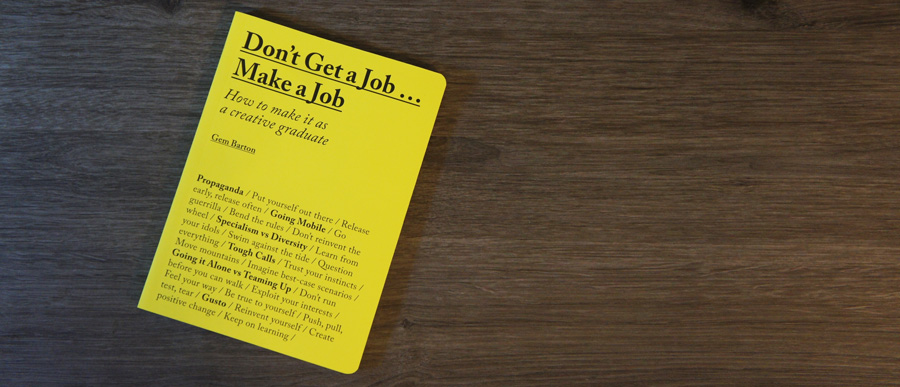Don’t Get a Job… Make a Job
‘Have big ideas and don’t be afraid of them. In fact, nurture your weirdest ideas, feed them, water them and let them grow into wild and wondrous things that no one else could dream of.’
Powerful words of encouragement from Gem Barton, author of ‘Don’t Get a Job… Make a Job’ which aims to inspire creative graduates through case study examples demonstrating a variety of work options outside of formal employment. Design Insider met with her to discuss her career, publication and to question how an employer can harness the creativity of graduates who are reluctant to enter a traditional workplace.
Gem Barton has been Course Leader on the BA (Hons) Interior Architecture degree at Brighton University since 2015, following 10 years of balancing teaching with writing, designing and curating. Gem is aware of the irony in her becoming a full time employee coinciding with the launch of her book encouraging non-conformity.
Gem studied Architecture Part 1 & Part 2 and after graduating in 2006, found employment but whilst working towards her professional exams Gem was made redundant. A second redundancy led Gem to readdress her career path and resulted in her taking this as a sign to take the opportunity to stop her educational progress. Gem moved to Brighton and embraced the city’s creative culture, beginning by curating a sculpture exhibition which found national success resulting in a further exhibition being picked up by Tate Britain in 2012.
‘If you focus on your goal, you can sometimes miss out of the steps in between. Brighton is all about encouraging people to take each of those steps.’
Gem’s own experience made her excellently placed to write ‘Don’t Get a Job… Make a Job’ which was published earlier this year. For 3 years Gem had been writing about the creative industries for a wide range of publications and in 2013/14 she produced her own online magazine Edge Condition.
After being approached by publishers Laurence King, Gem grasped the opportunity to write a book which aims to empower design graduates to find their own career path. ‘Don’t Get a Job… Make a Job’ gives carefully researched and curated examples of designers who have forged their own career path and includes advice from industry leading professionals. Several case studies start by explaining that the designer gained experience through unpaid internships, although this is often considered standard within the design sector the BCFA work to encourage members to pay interns, and when this point was put to the author she gave an interesting response:
‘It all comes down to what you consider payment. I consider payment as an exchange of something which each person considers valuable, so a classic example this summer would be going to a festival for free in return for working behind the bar… We are in a trade economy, a sharing economy.’
Gem continues to explain that graduates should feel suitably paid in return for their skills, they should feel confident to negotiate with a business when discussing an internship, and an employer should be prepared to discuss skills, software or experiences which the graduate feels are key to their own career, whether paid or unpaid.
When reading’ Don’t Get a Job… Make a Job’ the overriding concept is that of self employment and running your own business and the case studies give inspiring examples of how this can be achieved and the success it can result in. It was interesting to hear Gem speak of the ways in which she feels her case studies also inspire the reader to find their own route into employment. She explained how self started and self initiated projects can build the designer’s confidence, builds contacts and a portfolio, and how this can open doors with the employers they would like to work for. The key case study supporting employment is Rui Pereira who gives the following advice:
‘My advice to new designers is to always be alert to what surrounds you, work for others before you start your own studio, and be very patient.’
Sapore dei Mobili, image courtesy of Rui Pereira
When reading other case studies it was difficult not to be struck that some of the designers were rather arrogant, the most notable being Andrew Merritt from Something & Son:
‘I couldn’t and wouldn’t be employed by anyone, as I was idea driven, and no one is going to employ an ideas person – that means being the director/head honcho/founder, and who’s going to employ a graduate to be one of those?’
Surely employers are keen to find idea driven designers?
Gem feels that the proportion of arrogance within the book is comparable to that within the industry and that there will always be people who don’t want to conform, who don’t want to climb the ladder. She references architect graduates who after spending seven years training can quickly become disheartened starting at the bottom of a practise, explaining that graduates can feel frustrated in a formal, restrictive roles.
The view of the employer is important to Gem, she had already begun to consider how a business can be attractive to design graduates who are looking for their need for freedom to be accommodated and feels that by embracing flexibility, collaborations and an employee’s independent projects an employer can reap the rewards. Gem gave the example of a Brighton based collective who employed a German designer on a 3 month contract, the designer negotiated a sabbatical from his employer to take the opportunity, which has resulted in a rich experience for the designer, a happy employee and a new collaborative relationship between the two companies. This point is key; is this how businesses will build lasting relationships with their creative designers? Could this approach have financial reward?
Gem feels that in order to harness the creative potential of the designers who feel less inclined to be an employee a business should start by reviewing their recruitment procedures. Employers should consider all advertising avenues including those further afield and consider a range of contract options, which will increase the base of talent they can call on, and consider a less formal or more creative interview style, she summarises:
‘In the same way in which potential employees need to find look at a new ways to find that job, employers need to find a new way to find an employee.’
When you read ‘Don’t Get a Job… Make a Job’ be sure not to miss the many ways in which it can empower graduates to have confidence in their own skills and how self initiated projects can lead the designer down new paths, in turn creating a varied and attractive portfolio which attracts their desired employer. It would be easy to read the case studies as examples of how being self employed is the only or most attractive option. But with developing workplace cultures and a more accommodating business approach perhaps graduates should have the confidence to negotiate their ideal contract with an employer and reap the rewards of working for some of the most exciting design and manufacture brands in the world?
We would love to know you opinion, please comment here or join our conversation on twitter.






